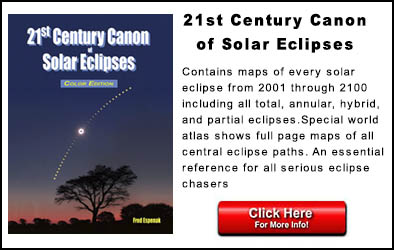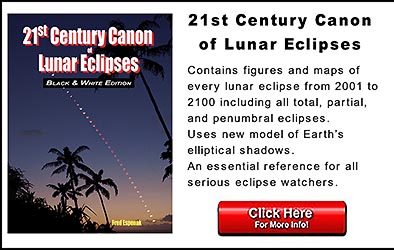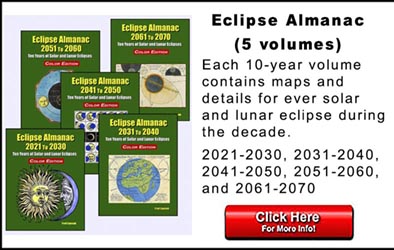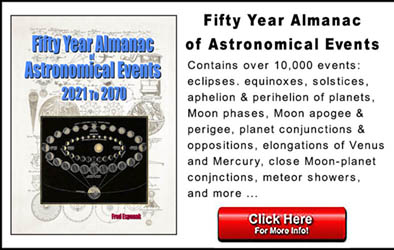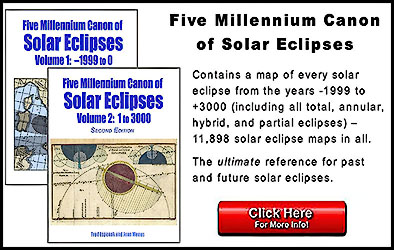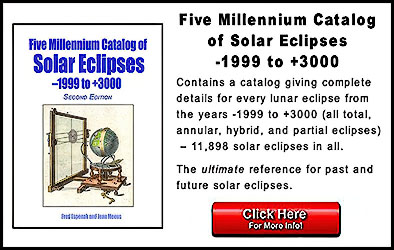Eclipses During 2023
By Fred Espenak
Based on the Article Published in
Observer's Handbook
2023
,
Royal Astronomical Society of Canada
In 2023, there are 2 solar eclipses and 2 lunar eclipses:
| Eclipses During 2023 | |||
| 2023 Apr 20: Hybrid Solar Eclipse | |||
| 2023 May 05: Penumbral Lunar Eclipse | |||
| 2023 Oct 14: Annular Solar Eclipse | |||
| 2023 Oct 28: Partial Lunar Eclipse | |||
| Eclipses During 2023 | |||
|
Hybrid Solar Eclipse 2023 Apr 20 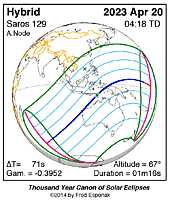
|
Penumbral Lunar Eclipse 2023 May 05 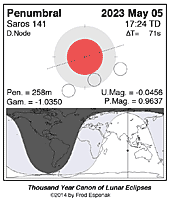
|
Annular Solar Eclipse 2023 Oct 14 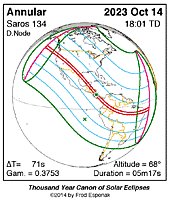
|
Partial Lunar Eclipse 2023 Oct 28 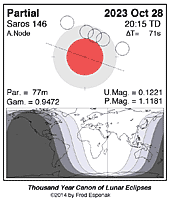
|
Unless otherwise stated, all times and dates used in this publication are in Coordinated Universal Time or UTC [1]. This astronomically derived time system is colloquially referred to as Greenwich Mean Time or GMT. To learn more about UTC and how to convert UTC to your own local time, see Time Zones and Universal Time.
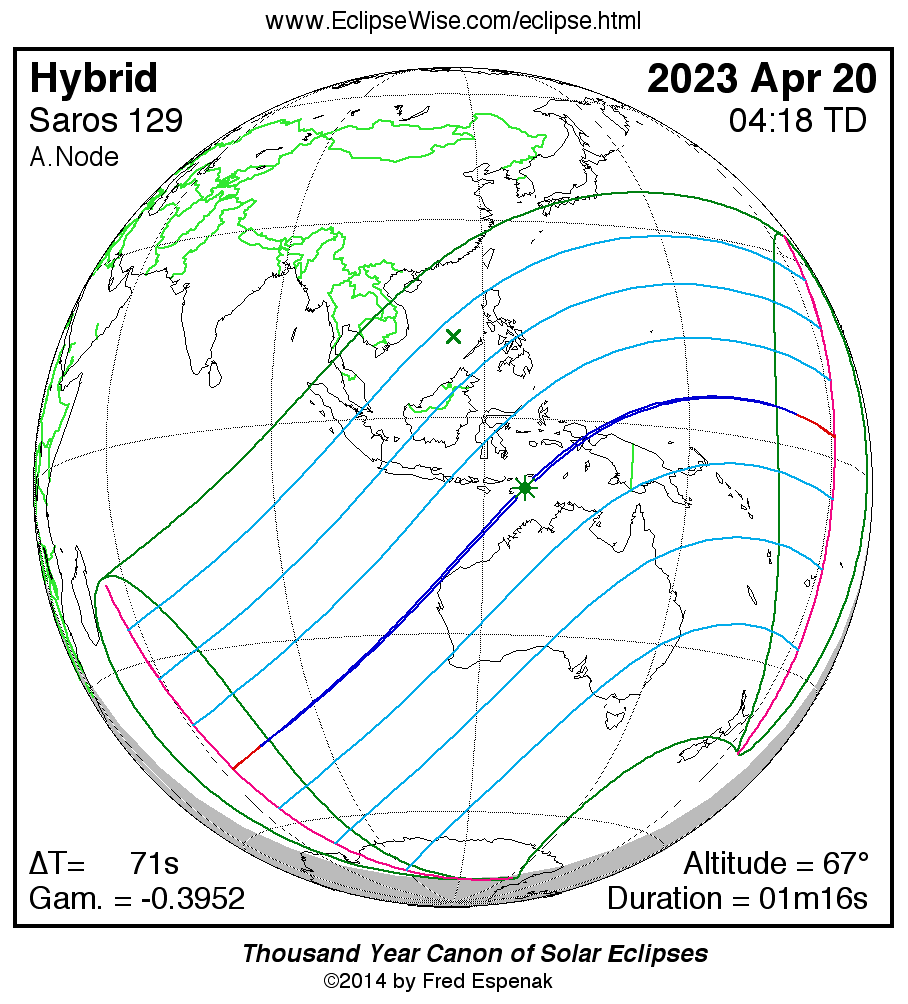
Click for larger more detailed figure
Hybrid Solar Eclipse of 2023 Apr 20
The first solar eclipse of 2023 is of an uncommon type known as a hybrid or annular-total eclipse. This is a unique class of central eclipse where some sections of the path are annular while other parts are total. The duality comes about when the vertex of the Moon's umbral shadow pierces Earth's surface at some points but falls short of the planet along other sections of the path. The unusual geometry is due to the curvature of Earth's surface which brings some geographic locations into the umbra while other positions are more distant and enter the antumbral rather than the umbral shadow. In most cases (as in 2023), the central path begins annular, changes to total for the middle portion of the track and reverts to annular towards the end of the path. However, it is also possible for the central path to begin annular and end total (e.g. - 2013 Nov 03) or vice versa (e.g. - 2386 Apr 29). Since these events occur near the vertex of the Moon's umbral/antumbral shadows, the central path is typically quite narrow.
The hybrid eclipse of 2023 will be visible from within a thin corridor, which traverses the Eastern Hemisphere (Figure 1). The path of the Moon's shadow begins in the southern Indian Ocean near the Kerguelen Islands and stretches northeast barely touching western Australia, crossing though Indonesia, and ending in the Pacific Ocean about 3000 kilometers southeast of the Hawaiian Islands. A partial eclipse will be seen within the much broader path of the Moon's penumbral shadow, which includes Australia, Indonesia, northern New Zealand, and much of the western Pacific.
The central eclipse track begins at 02:37 UTC as a 6-kilometer-wide annular path with a duration of 6 seconds. However, the path quickly narrows to a slender corridor of beaded annulariry within the first 2 minutes of its trajectory. Continuing along its northeastern course, the path becomes total as it rapidly expands in width. Unfortunately, no Indian Ocean islands fall within the path of totality. At 03:28 UTC, the umbral shadow reaches the Ningaloo Coast of Western Australia (Figure 2a). This UNESCO World Heritage Site includes one of the longest near-shore reefs in the world. Running along Australia's North West Cape, the path of totality engulfs the Cape Range National Park and the port town of Exmouth where the central line duration of totality lasts 1 minute 3 seconds with the Sun 54° above the horizon.
The path also crosses Australia's Barrow Island a working oilfield and an important nature reserve. Unfortunately, there is no public access to Barrow Island.
At greatest eclipse [2] (04:16:47 UTC), the duration of totality is 1 minute and 16 seconds, the path width is 49 kilometers, and the Sun's altitude is 67°. Three minutes later, the umbra makes its next landfall across the island nation of Timor-Leste(Figure 2b). The path of totality then crosses West Papua, a province of Indonesia (Figure 2c). The central line duration of totality here drops to 1 minute 10 seconds.
As the shadow proceeds along its watery trajectory, the path narrows as the length of totality dwindles. The track passes south of the islands of Micronesia. Southeast of the Marshal Islands, the eclipse becomes annular again at 05:54 UTC. Two minutes later, the central path ends at sunset (05:56 UTC) where a broken ring (due to the Moon's higher mountains along the limb) of annularity will last 11 seconds. Over the course of 3 hours 19 minutes, the Moon's central shadow traverses a 13,800-kilometer-long track covering a scant 0.07% of Earth's surface area. Path coordinates and central line circumstances are presented in Table 1.
Local circumstances for major cities are given in Table 2. All times are provided in Local Time. The Sun’s altitude and azimuth, the eclipse magnitude [3], and obscuration [4], are all listed for the instant of maximum eclipse.
The 2023 Apr 20 Solar Eclipse Circumstances Calculator is an interactive web page that can quickly calculate the local circumstances for the eclipse from any geographic location not included in the table.
The path of the eclipse is plotted on an interactive map at Google Map of the 2023 Apr 20 Solar Eclipse . This map permits zooming and scrolling as desired. Clicking the cursor on any location calculates the eclipse circumstances for that location. For more information see Key to Google Eclipse Maps.
This is the 52nd eclipse of Saros [6] series 129, a middle-aged series, which produced its first central eclipse (annular) on 1464 May 06. Three hybrid eclipses occur on 1987 Mar 29, 2005 Apr 08, and 2023 Apr 20. The next eclipse in the series will be total on 2041 Apr 30. The entire series is composed of 80 solar eclipses in the following sequence: 20 partial, 29 annular, 3 hybrid, 9 total, and 19 partial eclipses (Espenak and Meeus, 2021a). Saros series 129 runs from the years 1103 to 2528.
Complete details for the 80 eclipses in the series may be found at Saros 129.
For more information about this eclipse, see the EclipseWise Prime Page at Hybrid Solar Eclipse of 2023 Apr 20.
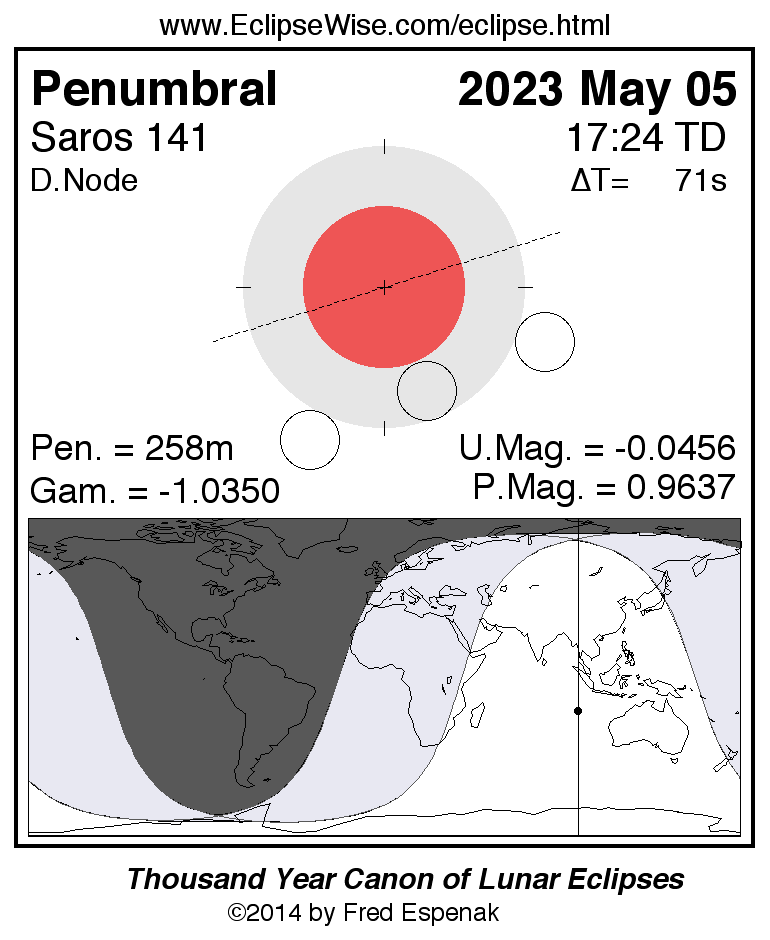
Click for larger more detailed figure
Penumbral Lunar Eclipse of 2023 May 05
The second eclipse of the year is a penumbral lunar eclipse occurring at the lunar orbit's descending node in Libra. This is a very deep penumbral eclipse with a penumbral magnitude [10] of 0.9655 and an eclipse duration of 258.3 minutes.
The Moon passes through the southern part of Earth’s penumbral shadow as shown in Figure 3. The times of the major eclipse phases are as follows.
Penumbral Eclipse Begins: 15:13:40.5 UTC
Greatest Eclipse: 17:22:55.2 UTC
Penumbral Eclipse Ends: 19:31:56.1 UTC
The beginning and end of a penumbral eclipse are not visible to the naked eye. In fact, no shading can be detected until about 2/3 of the Moon's disk is immersed in the penumbra. This would correspond to about 16:40 UTC when the penumbral eclipse is first detectable. Keep in mind that this is only an estimate. Atmospheric conditions and the observer's visual acuity are important factors to consider. An interesting exercise is to note when penumbral shading is first and last detected with the naked eye or binoculars.
At the instant of greatest eclipse [7] (17:22:55.2 UTC), the Moon lies at the zenith for a point in the Indian Ocean. The entire event is visible from most of Africa, Eastern Europe, Asia, Australia, and New Zealand. None of the eclipse will be visible from North America and South America.
The May 05 eclipse is the 24th eclipse of Saros series 141 [6]. The series is composed of 72 lunar eclipses in the following sequence: 24 penumbral, 7 partial, 26 total, 7 partial, and 8 penumbral eclipses (Espenak and Meeus, 2021b). Saros 141 spans 1280.1 years and runs from the years 1608 to 2888.
Complete details for the 72 eclipses in the series may be found at Saros 141.
For more information about this eclipse, see the EclipseWise Prime Page at Penumbral Lunar Eclipse of 2023 May 05
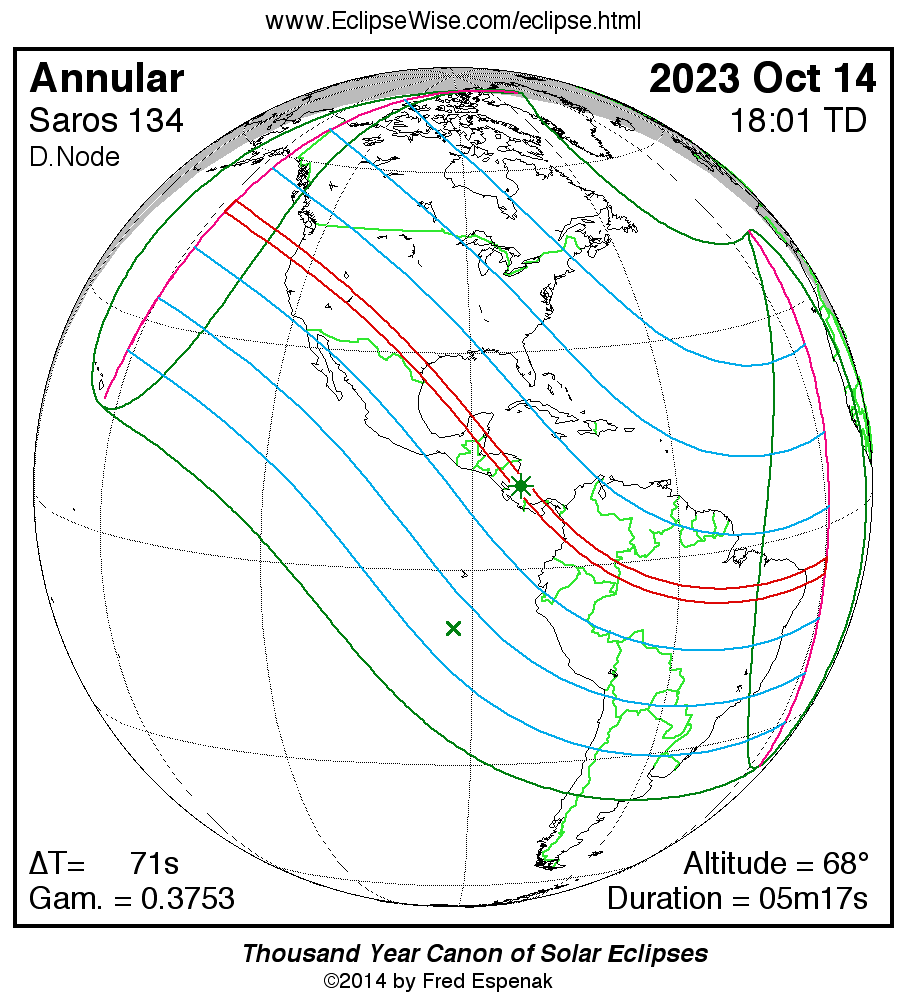
Click for larger more detailed figure
Annular Solar Eclipse of 2023 Oct 14
The second solar eclipse of 2023 is visible from the Western Hemisphere. Most of North, Central, and South America, will be in the path of the Moon’s penumbral shadow (Figure 4). The antumbra crosses parts of North, Central, and South America.
The path of the annular eclipse begins in the North Pacific at 16:12 UTC where the Moon's antumbral shadow meets Earth and forms a 245-kilometer-wide corridor. The duration of the annular phase here is 4 minutes 19 seconds. Rushing southeast, the antumbra quickly reaches the Pacific coast of Oregon (16:16 UTC). At this location, the path is 220 kilometers wide, the central duration of the annular phase is 4 minutes 34 seconds, and the Sun's altitude is 17°.
Continuing across the western United States, the annular track traverses portions of nine states: Oregon, California, Idaho (only a small corner of southwestern Idaho lies in the path of annularity), Nevada, Utah, Colorado, Arizona, New Mexico, and Texas (Figure 5A)). By the time the antumbra reaches the Gulf coast of Texas (16:56 UTC), the path is 190 kilometers wide, the central duration of the annular phase is 5 minutes 2 seconds, and the Sun's altitude is 50°.
The annular track also crosses Mexico’s Yucatan Peninsula, and parts of six Central American nations: Guatemala, Belize, Honduras, Nicaragua, Costa Rica, and Panama (Figure 5B). The instant of greatest eclipse [2] occurs at 17:59:31 UTC just off the eastern coast of Nicaragua where the duration of annularity is 5 minutes 16 seconds, the path width is 190 kilometers, and the Sun's altitude is 68°. The eclipse magnitude is 0.952 and the eclipse obscuration is 0.907.
After Central America, the path of annularity sweeps across Colombia and Brazil (Figure 5C) ending in the Atlantic Ocean at 19:46 UTC.
Over the course of 3 hours and 34 minutes, the Moon's antumbral shadow traverses a 13,800-kilometer-long track covering 0.57% of Earth's surface area. Path coordinates and central line circumstances are presented in Table 3.
Local circumstances for a selection of cities in Canada and the USA are given in Table 4A (Canada), Table 4B (USA – Partial), and Table 4C (USA - Annular). All times are provided in Local Time. The Sun’s altitude and azimuth, the eclipse magnitude [3], and obscuration [4] are all listed for the instant of maximum eclipse.
The 2023 Oct 14 Solar Eclipse Circumstances Calculator is an interactive web page that can quickly calculate the local circumstances for the eclipse from any geographic location not included in Table 4A, 4B, and 4C.
The path of the eclipse is plotted on an interactive map at Google Map of the 2023 Oct 14 Solar Eclipse . This map permits zooming and scrolling as desired. Clicking the cursor on any location calculates the eclipse circumstances for that location. For more information see Key to Google Eclipse Maps.
This is the 44th eclipse of Saros [6] series 134. The entire series is composed of 71 solar eclipses in the following sequence: 10 partial, 8 total, 16 hybrid, 30 annular, and 7 partial eclipses (Espenak and Meeus, 2021a). Saros 134 lasts 1262.1 years running from 1248 to 2510. Complete details for the xx eclipses in the series may be found at Saros 134.
For more information about this eclipse, see the EclipseWise Prime Page at Annular Solar Eclipse of 2023 Oct 14.

|

|
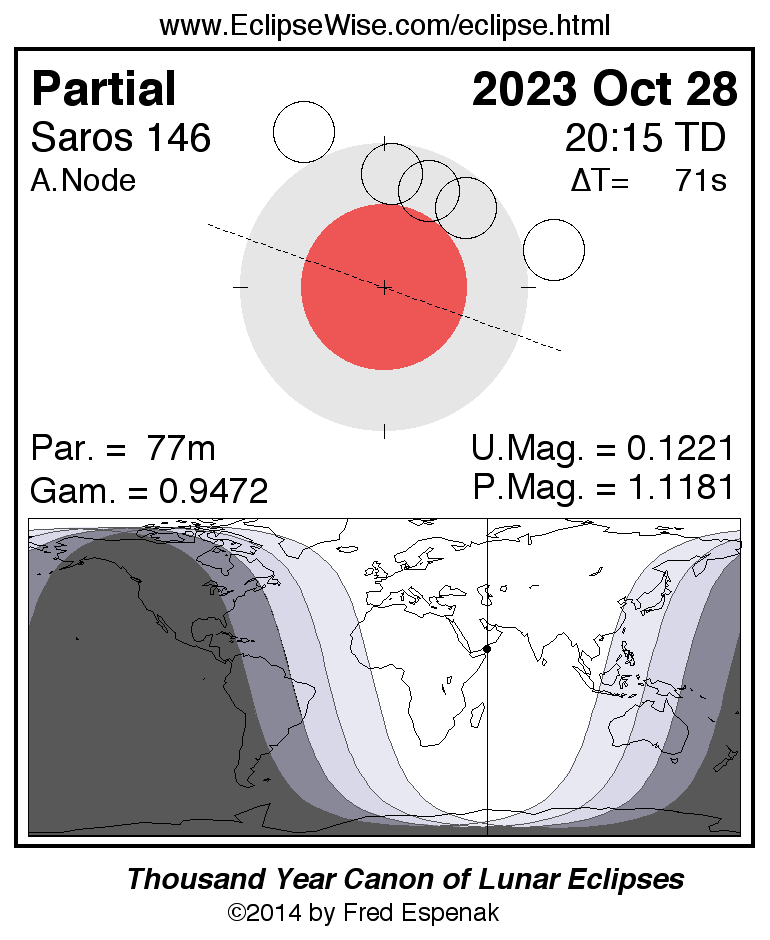
Click for larger more detailed figure
Partial Lunar Eclipse of 2023 Oct 28
The last eclipse of the year is a partial lunar eclipse. Once again, the event is well placed for the Eastern Hemisphere. The eclipse occurs at the ascending node of the Moon’s orbit in southern Aries. Occurring 2.7 days after perigee (Oct 26 at 02:54 UTC), the Moon will appear 32.4 arc minutes in diameter. This is a relatively shallow partial eclipse with an umbral eclipse magnitude [8] of 0.1239. At mid-eclipse the Moon’s southern limb dips just 4.2 arc minutes into the umbral shadow.
The Moon’s path through Earth’s shadows and a map illustrating worldwide visibility of the event are shown in Figure 6. The times of the major eclipse phases are listed as follows.
Penumbral Eclipse Begins: 18:01:18.5 UTC
Partial Eclipse Begins: 19:34:43.3 UTC
Greatest Eclipse: 20:14:07.8 UTC
Partial Eclipse Ends: 20:52:52.2 UTC
Penumbral Eclipse Ends: 22:26:34.9 UTC
The instant of greatest eclipse [7] (20:14:07.8 UTC) occurs with the Moon in the zenith for a point near the southern coastline of Yemen. This eclipse is visible from Europe, Africa, most of Asia, and western Australia. None of the eclipse is visible from the Americas except for easternmost Canada where part of the eclipse is already in progress at Moonrise.
The Oct 28 eclipse is the 11th eclipse of Saros 146 [6]. This series is composed of 72 lunar eclipses in the following sequence: 9 penumbral, 20 partial, 17 total, 19 partial, and 7 penumbral eclipses (Espenak and Meeus, 2021b). Saros 146 spans 1280.1 years and runs from 1843 Jul 11 to 3123 Aug 29. Complete details for the 72 eclipses in the series may be found at Saros 146.
For more information about this eclipse, see the EclipseWise Prime Page at Partial Lunar Eclipse of 2023 Oct 28
Explanatory Information
Solar Eclipse Figures
Lunar Eclipse Figures
Enlargement of Earth's Shadows and Lunar Eclipses
Danjon Scale of Lunar Eclipse Brightness
Moon's Apparent Magnitude During Total Lunar Eclipses
Crater Timings During Lunar Eclipses
Eclipse Altitudes and Azimuths
The altitude a and azimuth A of the Sun or Moon during an eclipse depend on the time and the observer's geographic coordinates. They are calculated as follows:
h = 15 (GST + UT - α ) + λ
a = arcsin [sin δ sin φ + cos δ cos h cos φ]
A = arctan [-(cos δ sin h)/(sin δ cos φ - cos δ cos h sin φ)]
where
h = hour angle of Sun or Moon
a = altitude
A = azimuth
GST = Greenwich Sidereal Time at 0:00 UT
UT = Universal Time
α = right ascension of Sun or Moon
δ = declination of Sun or Moon
λ = observer's longitude (east +, west -)
φ = observer's latitude (north +, south -)
During the eclipses of 2023 , the values for GST and the geocentric Right Ascension and Declination of the Sun or the Moon (at greatest eclipse) are as follows:
Eclipse Date GST α 7 δ
Hybrid Solar 2023 Apr 20 13.867 1.850 11.415
Penumbral Lunar 2023 May 05 14.888 14.807 -17.242
Annular Solar 2023 Oct 14 1.535 13.302 -8.244
Partial Lunar 2023 Oct 28 2.461 2.163 14.084
Two web based tools that can also be used to calculate the local circumstances for all solar and lunar eclipses visible from any location. They are the Javascript Solar Eclipse Explorer and the Javascript Lunar Eclipse Explorer. The URLs for these tools are:
Javascript Solar Eclipse Explorer: www.EclipseWise.com/solar/JSEX/JSEX-index.html
Javascript Lunar Eclipse Explorer: www.EclipseWise.com/lunar/JLEX/JLEX-index.html
Eclipses During 2024
In 2024, there are 2 solar eclipses and 2 lunar eclipses:
| Eclipses During 2024 | |||
| 2024 Mar 25: Penumbral Lunar Eclipse | |||
| 2024 Apr 08: Total Solar Eclipse | |||
| 2024 Sep 18: Partial Lunar Eclipse | |||
| 2024 Oct 02: Annular Solar Eclipse | |||
| Eclipses During 2024 | |||
|
Penumbral Lunar Eclipse 2024 Mar 25 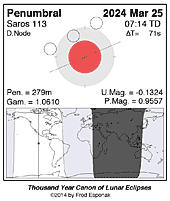
|
Total Solar Eclipse 2024 Apr 08 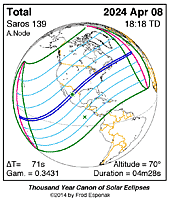
|
Partial Lunar Eclipse 2024 Sep 18 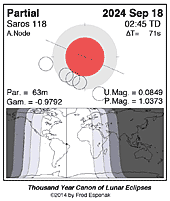
|
Annular Solar Eclipse 2024 Oct 02 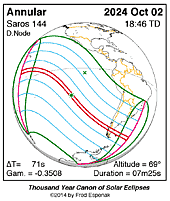
|
A full report Eclipses During 2024 will be published in Observer's Handbook:2024
Eclipse Web Sites
EclipseWise.com is a website dedicated to predictions and information on eclipses of the Sun and Moon. It offers a graphically intuitive interface and contains maps, diagrams, tables, and information about every solar and lunar eclipse from 2000 BCE to 3000 CE. This period includes 11898 solar eclipses and 12064 lunar eclipses.
Much of EclipseWise.com is based on the Thousand Year Canon of Solar Eclipses 1501 to 2500 (Espenak 2014a) and the Thousand Year Canon of Lunar Eclipses 1501 to 2500 (Espenak 2014b). These eclipse predictions use the Jet Propulsion Lab's DE406 — a computer ephemeris used for calculating high precision coordinates of the Sun and Moon for thousands of years into the past and future.
For eclipses over a larger time interval see Five Millennium Canon of Solar Eclipses –1999 to +3000 and Five Millennium Canon of Lunar Eclipses –-1999 to +3000.
The World Atlas of Solar Eclipses provides maps of all central eclipse paths from 2000 BCE to 3000 CE.
MrEclipse.com targets solar and lunar eclipse photography, with tips on eclipse observing and eye safety.
Acknowledgments
All eclipse predictions were generated on Macintosh computers using algorithms developed from the Explanatory Supplement [1974] with additional algorithms from Meeus [1989]. The solar and lunar coordinates used in the eclipse predictions are based on the JPL DE405. The difference between Terrestrial Time (TT) and Coordinated Universal Time (UTC) used in these predictions is 69.184 seconds (= 32.184 seconds plus 37 leap seconds).
For lunar eclipses, the elliptical shape of the umbral and penumbral shadows is calculated using Herald and Sinnott (2014) method of enlarging Earth's radius to compensate for the opacity of the terrestrial atmosphere (including corrections for the oblateness of Earth).
All calculations, diagrams, tables, and opinions presented in this paper are those of the author, and he assumes full responsibility for their accuracy.
Permission is granted to reproduce the eclipse data when accompanied by a link to this page and an acknowledgment:
"Eclipse Predictions by Fred Espenak, EclipseWise.com"
The use of diagrams and maps is permitted provided that they are unaltered (except for re-sizing) and the embedded credit line is not removed or covered.
Footnotes
[1] UTC or Coordinated Universal Time is the primary time standard that regulates world clocks and time. It is based on International Atomic Time (TAI) with leap seconds added at irregular intervals to compensate for the slowing of Earth's rotation. Leap seconds keep UTC within 0.9 second of UT1 (UT1 is mean solar time at 0° longitude). UTC is not adjusted for daylight saving time. It is effectively a successor to Greenwich Mean Time (GMT).
[2] The instant of greatest eclipse for solar eclipses occurs when the distance between the Moon's shadow axis and Earth's geocenter reaches a minimum.
[3] Eclipse magnitude for solar eclipses is defined as the fraction of the Sun's diameter occulted by the Moon.
[4] Eclipse obscuration is defined as the fraction of the Sun's area occulted by the Moon.
[5] For solar eclipses, gamma is the distance of the Moon's shadow axis from Earth's center (in Earth radii) when it reaches its minimum absolute value.
[6] The Saros is a period of 6,585.3 days (18 years 11 days 8 hours) in which eclipses (both solar and lunar) repeat. The geometry isn't exact but close enough for a Saros series to last 12 or more centuries.
[7] The instant of greatest eclipse for lunar eclipses occurs when the distance between the Moon and Earth's shadow axis reaches a minimum.
[8] Umbral eclipse magnitude is defined as the fraction of the Moon's diameter occulted by Earth's umbral shadow.
[9] For lunar eclipses, gamma is the distance of the Moon's center from Earth's shadow axis (in Earth radii) when it reaches its minimum absolute value.
[10] Penumbral eclipse magnitude is defined as the fraction of the Moon's diameter occulted by Earth's penumbral shadow.
References
Chauvenet, W., Manual of Spherical and Practical Astronomy, Vol.1, 1891 (Dover edition 1961).
Danjon, A., "Les éclipses de Lune par la pénombre en 1951," L'Astronomie, 65, 51-53 (Feb. 1951).
Espenak, F., Meeus, J., Five Millennium Canon of Solar Eclipses –1999 to +3000, 2nd Edition, AstroPixels Publishing, Portal, AZ, 2021.
Espenak, F., Meeus, J., Five Millennium Canon of Lunar Eclipses –-1999 to +3000, 2nd Edition, AstroPixels Publishing, Portal, AZ, 2021.
Espenak, F., Thousand Year Canon of Solar Eclipses 1501 to 2500, AstroPixels Publishing, Portal, AZ, 2014.
Espenak, F., Thousand Year Canon of Lunar Eclipses 1501 to 2500, AstroPixels Publishing, Portal, AZ, 2014.
Espenak, F., 21st Century Canon of Solar Eclipses, AstroPixels Publishing, Portal, AZ, 2016.
Espenak, F., 21st Century Canon of Lunar Eclipses, AstroPixels Publishing, Portal, AZ, 2020.
Espenak, F., Atlas of Central Solar Eclipses in the USA, AstroPixels Publishing, Portal, AZ, 2016.
Explanatory Supplement to the Astronomical Ephemeris and the American Ephemeris and Nautical Almanac, Her Majesty's Nautical Almanac Office, London, 1974.
Herald, D., and Sinnott, R. W., “Analysis of Lunar Crater Timings, 1842–2011,” J. Br. Astron. Assoc., 124, 5, 2014.
Keen, R. A., "Volcanic Aerosols and Lunar Eclipses", Science, vol. 222, p. 1011-1013, Dec. 2, 1983.
Meeus, J., Elements of Solar Eclipses 1951-2200, Willmann-Bell, Richmond, VA (1989).

